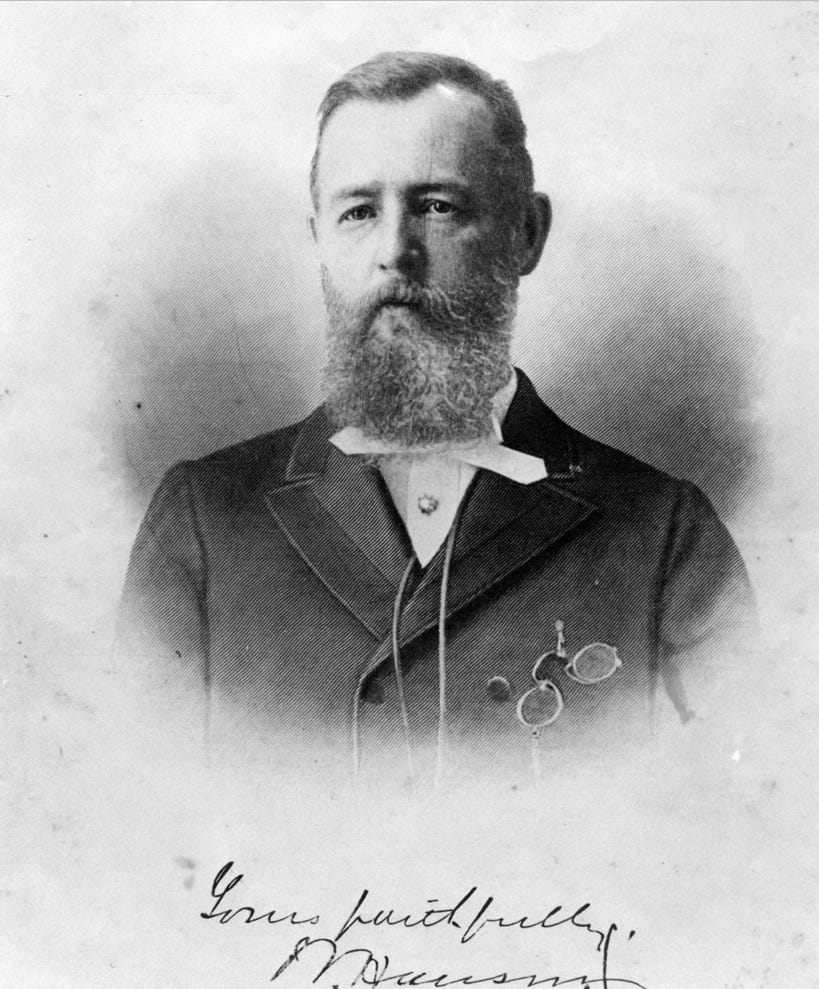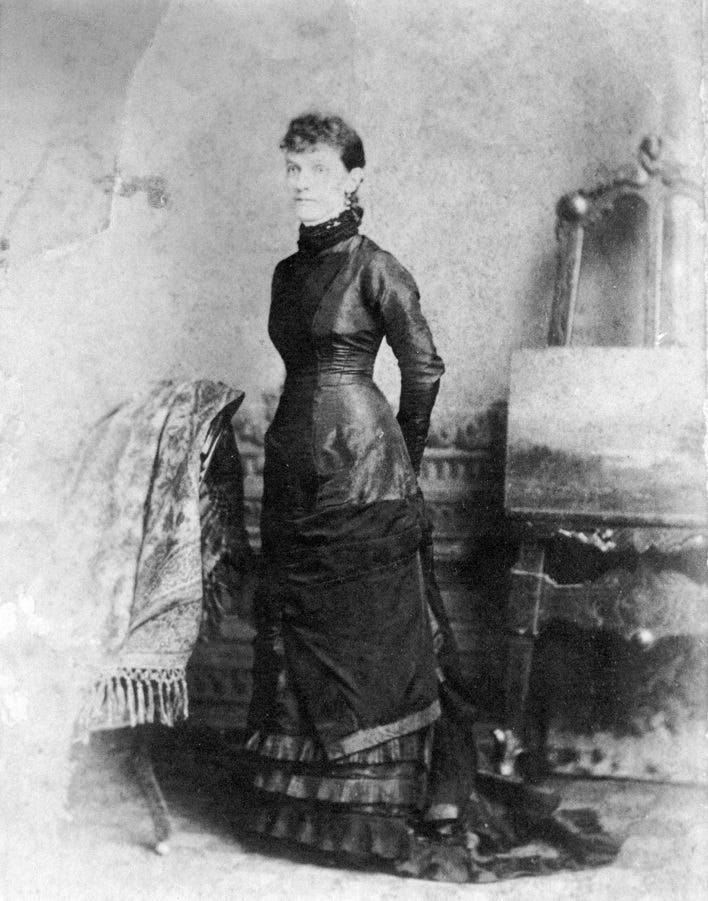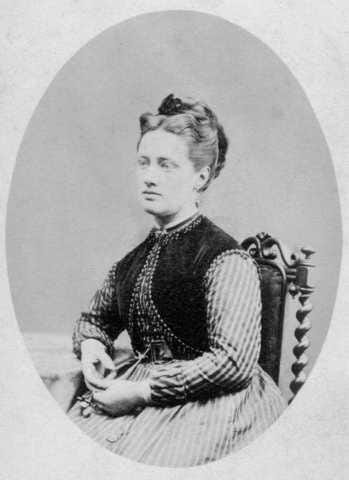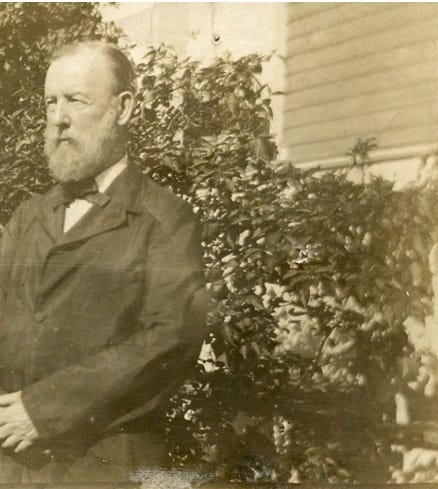Meet the Cast: William and Julia Hanson
A spotlight on historic characters in Southwest Florida
Writer William Stanley Hanson (Stanley), best known for his advocacy for the Seminole Indian tribe, once likened Fort Myers to the Sargasso Sea. It was said that a message in a bottle dropped from anywhere would eventually wash up in its waters.
“It seems,” he said, “that all the great people in the world have at one time or another drifted to Fort Myers.” (The Fort Myers Press, Feb. 22, 1931)
Certainly it was a strange meander that brought his parents, Britons Julia and Dr. William Hanson, to live in Fort Myers in April 1884, just a few months before the town’s newspaper was founded and a year before Edison “discovered” the place. As chronicled by the newspaper to the end of their days and after, Dr. and Mrs. Hanson were vital to the community.
(Dr. William Hanson, courtesy of Hanson Family Archives)
En Route to Cuba
Dr. William Hanson purchased 20 acres of land on the Caloosahatchee River in Fort Myers in April 1883 from Manuel A. Gonzalez. The Hansons were then living in Paris, Texas. Previously they had lived for eight years in Wales, where their two older sons, Bernie and Newton, were born. A three-week old son, Melville, died in Texas, and Julia was pregnant again when the family headed for Cuba.
Medicine was Dr. Hanson’s vocation, but agriculture was his passion. Later in Fort Myers he cultivated a choice strain of tobacco and propagated numerous citrus and other trees. My guess is that the family was headed to Cuba for a chance at owning a tobacco farm there. But Julia went into labor in Key West in late November 1883, giving birth to Stanley, and the family settled there for a few months, with Dr. Hanson putting his shingle up for his medical practice.
(Julia Hanson, courtesy of Hanson Family Archives)
“Virtue Alone is Invincible”
Dr. William Hanson was born to a prominent family in Essex, Great Britain, in 1842. His ancestors included William the Conqueror. His grandfather was Lord Byron’s tutor, and his grandmother was the sister of the cursed 10th Viscount Montague, whose wrecked castle, Cowdray House, stands in ruins in Midhurst. The family crest was certified in 1652, with its motto “Sola Virtus Invicta: Virtue alone is invincible.”
Julia Allen Hanson was born in 1843 in London to a well-known architect, George Allen, who had produced sketches of the approach to the London bridge that were incorporated into its design. He died in 1847, leaving his wife, Maria, with six children ages 10 and under. The family was well-off: Julia studied with tutors and attended college. An accomplished artist, the pretty redhead also served as an artist’s model for Edward Burne-Jones and others. She hunted foxes with Anthony Trollope and went to garden parties with Alfred Tennyson’s wife.
(Julia at 25, from ancestry.com)
William Hanson took a job after college with the Bank of British North America, which sent him to the wilds of Canada and the balmy South Seas. His banking career ended in Mexico. As his late grandson, Stan Hanson, recounted in a talk to the Southwest Florida Historical Society, William Hanson was taking silver from the beleaguered Emperor Maximilian back to Great Britain when he was kidnapped by forces from Maxmillian’s opposition, Benito Juarez, in Acapulco. He was saved when the steamer he had arranged to pick up the silver showed up.
He then studied medicine at the Royal College of Physicians and Surgeons at Edinburgh, Scotland. He married Julia the year he graduated, 1870.
To America
Most of Julia’s siblings were adventurous. Her brother George, an architect, married William Hanson’s sister Carrie and moved to New Zealand, where he designed some of its most striking cathedrals and other buildings. Julia’s sister married a missionary in South Africa, and a brother became a newspaper editor in Canada.
Dr. Hanson suffered from asthma, which is what led them to Texas in 1880 and later Florida. When the couple arrived in Fort Myers, they threw themselves into community work. With Mary Verdier Parker, whose family had established the Episcopal Church in Tampa, Julia worked to establish a branch of their faith. Dr. Hanson donated the land for the first church building.
In a town of fewer than 500 people, there wasn’t a lot of doctoring to do, but Hanson did it. In the newspaper, he was often thanked for his services by patients, but he almost certainly received more gratitude than cash. Like his friend F.A. Hendry, he became a trusted figure to the Seminole Indians. They often showed up at his home for care, and he took his medical bag to them in the Everglades when alerted that he was needed.
His career had a couple of brushes with fame: He treated villainous plume hunter Jean Chevalier for a gunshot wound, and he signed Cyrus Teed’s death certificate as Teed’s weeping followers waited for him to resurrect.
Ventures and Busts
By the mid-1880s, Dr. Hanson was a developer, selling lots in “Hanson’s addition” at the southern border of town. He was also the managing partner of South Florida Tropical Fruit Co., a Wales-based venture investing in Lee County agriculture. About five miles south of town, Hanson was growing pineapples, oranges, and tobacco on land owned by the company.
The tobacco leaf he cultivated was praised by General Cerro Gordo Williams, a Kentuckian who co-founded the town of Naples. Reached at his home in New Jersey by a Florida newspaperman to ask him what he thought about Hanson’s “Fort Myers leaf,” Thomas Edison said, “So Hanson has made a success of his venture, has he? I am glad to hear it; he is deserving of it for his pluck… Remember me kindly to the Doctor when you see him.” (Fort Myers Press, June 20, 1889)
(Dr. William Hanson in Fort Myers, courtesy Hanson Family Archives)
It's unclear what happened to the company – the newspaper announced its dissolution in 1890, and assets were sold off. Dr. Hanson kept up citrus farming on his own behalf and wrote expert articles on grapefruit, oranges, and mangoes. But his attention was also captivated by the promises of phosphate.
Phosphate was in demand in Europe and elsewhere for its agricultural uses and had been discovered in waters near Arcadia. In 1890, several businessmen in Fort Myers, including Dr. Hanson, formed a company to mine it and were scouting local waters for the prehistoric “boneyards” from which it was extracted.
By late 1893, everyone involved had lost a tremendous amount of money. The Hanson family was forced to sell some of their land at fire sale prices. Dr. Hanson went back to Key West to practice medicine, leaving his family for weeks at a time until returning to Fort Myers full-time in 1895.
A Real Community
But they never gave up on Fort Myers. No matter how many booms and busts the Hansons or the town went through, William and Julia Hanson stayed steady, constantly looking for ways to give back.
Julia was instrumental in founding the literary society, the reading room, and the Fort Myers Woman’s Club, for which she served as president for 29 years. She wrote humorous poems for the newspaper about civic needs.
No one was more aware of the need for a good hospital in Fort Myers than Dr. Hanson, and he and his wife were working on a fundraising appeal for the building of one on a December night in 1911 when his heart stopped. Sadly, their eldest son Newton, who had caught malaria in the Spanish-American War, died the next week.
Julia’s son Stanley married Clara Petzold of Tarpon Springs a few months later, and Julia mostly made her home with them until her death, although she traveled often. Stanley and Julia continued Dr. Hanson’s advocacy for the Seminole Indians (more on that later). Mother and son were also two of the leading lights in the fight against the slaughter of water birds for hat plumes.
Julia was gravely ill in November 1934 at Stanley and Clara’s home on Monroe Street. Her son Bernie came from Dallas to say goodbye. With her sons and other family in attendance, she passed away.
The world and its sorrows had tried her, friend Mary Elizabeth Byrd wrote of Julia a few years before her death, “but it had not found her wanting. All who know her well love to think of her.”









I love that Julia did so much to cultivate and support literacy in the area!
This one was EXTRA delicious. So juicy! I love it. Thank you.